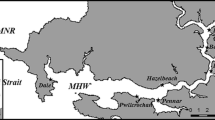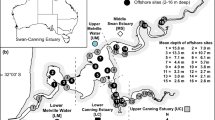Abstract
The Fucus populations on rocky shores along 300 km of the coastal waters of southeast Sweden in the Baltic proper have been studied since 1984 at a number of fixed sites as part of monitoring programmes. This paper describes changes in distribution and abundance of F. vesiculosus and F. serratus during the period 1984–2001. Sheltered sites showed a consistent temporal and spatial pattern of Fucus spp. distribution over a coastline of 300 kilometres. The depth penetration and abundance of Fucus spp. increased during the 1980s. Around 1990 the development reversed as a consequence of grazing and in 1997 many sites were almost devoid of Fucus spp. Since 1998 both abundance and depth penetration have increased again, possibly as a result of local measures against eutrophication. Exposed sites, on the other hand, lost their Fucus populations at the beginning of the 1990s, and they have not recovered. Extended field studies lead us to deduce that the fixed sites referred to above were representative of the Fucus populations in the area investigated. Major declines, both at sheltered and exposed sites, are attributed to grazing by the isopod Idotea baltica. The populations of I. baltica may have been favoured by the continuing eutrophication of the Baltic, a series of mild winters in the 1990s, and a contemporary decline in some potential predators.
Similar content being viewed by others
References
Anon. 2002. Report of the Baltic Fisheries Assessment Working Group. ICES CM 2002/ACFM: 17.
Berger R., Henriksson E., Kautsky L. and Malm T. 2003. Effects of filamentous algae and deposited matter on the survival of Fucus vesiculosus L. germlings in the Baltic Sea. Aquat. Ecol. 37: 1–11.
Beukema J.J. 1992. Expected changes in the Wadden Sea benthos in a warmer world: Lessons from periods with mild winters. Proceedings of the 26th European marine biology symposium. Biological effects of disturbances on estuarine and coastal marine Environments. Neth, J. Sea Res. 30: 73–79.
Cederwall H. and Elmgren R. 1990. Biological effects of eutrophication in the Baltic Sea, particularly the coastal zone. Ambio 19: 109–112.
Engkvist R., Malm T. and Tobiasson S. 2000. Density dependent grazing effects of the isopod Idotea baltica Pallas on Fucus vesiculosus L in the Baltic Sea. Aquat. Ecol. 34: 253–260.
Engkvist R., Malm T. and Nilsson J. 2004. Interaction between isopod grazing and wave action: a structuring force in macroalgal communities in the southern Baltic Sea. Aquat. Ecol. 38: 403–413.
Eriksson B.K., Johansson G. and Snoeijs P. 1998. Long-term changes in the sublittoral zonation of brown algae in the southern Bothnian Sea. Eur. J. Phycol. 33: 241–249.
Greenhouse S.W. and Geissner S. 1959. On methods in the analysis of profile data. Psychometrika 24: 95–112.
Haage P. 1976. Quantitative investigations of the Baltic Fucus belt macrofauna. Seasonal variations in biomass, reproduction and population dynamics of the dominant taxa. C. Askö Lab. Univ. Stock. 10: 1–84.
Haahtela I. 1984. A hypothesis of the decline of the bladder wrack (Fucus vesiculosus L.) in SW Finland in 1975–1981. Limnologica (Berlin) 15: 345–350.
Hauxwell J., McClelland J., Behr P.J. and Valiela I. 1998. Relative importance of grazing and nutrient controls of macroalgal biomass in three temperate shallow estuaries. Estuaries 21: 347–360.
Helminen U., Mäkinen A. and Rönnberg O. 2000. Aerial survey of recent changes in the occurrence of Fucus vesiculosus in the Archipelago Sea, SW Finland. Abstract at the Nessling Foundation Symposium, Man and the Baltic Sea, 2–3. 10 2000, Helsinki, Finland.
Hemmi A. and Jormalainen V. 2002. Nutrient enhancement increases performance of a marine herbivore via quality of its food alga. Ecology 83: 1052–1064.
Hurrell J.W. 1995. Decadal trends in the North Atlantic oscillation: regional temperatures and precipitation. Science 269: 676–679.
Håkansson L. 1981. A Manual of Lake Morphometry. Springer-Verlag, Berlin, Germany, 78 pp.
Hänninen J., Vuorinen I. and Hjelt P. 2000. Climatic factors in the Atlantic control the oceanographic and ecological changes in the Baltic Sea. Limnol. Oceanogr. 45: 703–710.
Isaksson I., Pihl L. and van Montfrans J. 1994. Eutrophication-related changes in macrovegetation and foraging of young cod (Gadus morhua L.): A mesocosm experiment. J. Exp. Mar. Biol. Ecol. 177: 203–217.
Jansson A-M. 1967. The food-web of the Cladophora-belt fauna. Helg. Wiss. Meer. 15: 574–588.
Jazdzewski K. 1970. Biology of Crustacea Malacostraca in the Bay of Puck, Polish Baltic Sea. Zoologica Pol. 20: 423–480.
Jones C.G., Lawton J.H. and Shachak M. 1994. Organisms as ecosystem engineers. Oikos 69: 373–386.
Kangas P., Autio H., Hällfors G., Luther H., Niemi A. and Salemaa H. 1982. A general model of the decline of Fucus vesiculosus at Tvärminne, south coast of Finland in 1977–81. Acta Bot. Fenn. 118: 1–27.
Kangas P. and Niemi Å. 1985. Observations of recolonization by the bladder wrack, Fucus vesiculosus, on the southern coast of Finland. Aqua Fenn. 15: 133–140.
Kautsky H. 2001. Små förändringar i växternas djuputbredning.. In: Tidlund A. and Ganning B. (eds), Miljötillståndet i Egentliga Östersjön Årsrapport 2000: 62–63. Stockholms Marina Forskningscentrum, Stockholm, Sweden (in Swedish with an English summary).
Kautsky H., Kautsky L., Kautsky N., Kautsky U. and Lindblad C. 1992. Studies on the Fucus vesiculosus community in the Baltic Sea. Acta Phytogeogr. Suec. 78: 33–48.
Kautsky H. and van der Maarel E. 1990. Multivariate approaches to the variation in phytobenthic communities and environmental vectors in the Baltic Sea. Mar. Ecol. Prog. Ser. 60: 169–184.
Kautsky N., Kautsky H., Kautsky U. and Wærn M. 1986. Decreased depth penetration of Fucus vesiculosus (L) since the 1940's indicates eutrophication of the Baltic Sea. Mar. Ecol. Prog. Ser. 28: 1–8.
Keats D.W., Steele D.H. and South G.R. 1987. The role of fleshy macroalgae in the ecology of juvenile cod (Gadus morhua L.) in inshore waters off eastern Newfoundland. Can. J. Zool. 65: 49–53.
Kiirikki M. 1996. Mechanisms affecting macroalgal zonation in the northern Baltic Sea. Eur. J. Phycol. 31: 225–232.
Kiirikki M. and Lehvo A. 1997. Life strategies of filamentous algae in the northern Baltic Proper. Sarsia 82: 259–267.
Koslowski G. and Loewe P. 1994. The Western Baltic Sea Ice Season in Terms of a Mass-Related Severity Index 1879 -1992. Part I: Temporal Variability and Association with the North Atlantic Oscillation. Tellus 46: 66–74.
Levring T. 1940. Studien über die Algenvegetationen von Blekinge Südschweden. PhD thesis, University of Lund, Lund, Sweden (in German).
Lindvall B. 1984. The condition of a Fucus-community in a polluted archipelago area on the east coast of Sweden. Ophelia Suppl. 3: 147–150.
Mäkinen A., Haathela I., Ilvessalo H. and Lehto J. 1984. Changes in littoral rocky shore vegetation in the Seili area, SW archipelago of Finland. Ophelia Suppl. 3: 157–166.
Malm T. 1999. Distribution patterns and ecology of Fucus serratus L. and Fucus vesiculosus L. in the Baltic Sea. PhD thesis, University of Stockholm, Stockholm, Sweden.
Malm T., Engkvist R. and Kautsky L. 1999. Grazing effects of two freshwater snails on juvenile Fucus vesiculosus in the Baltic Sea. Mar. Ecol. Prog. Ser. 188: 63–71.
Malm T. and Kautsky L. 2003. Differences in life-history characteristics are consistent with the vertical distribution pattern of Fucus serratus and Fucus vesiculosus (Fucales, Phaeophyceae) in the central Baltic Sea. J. Phycol. 39: 880–887.
Malm T., Kautsky L. and Engkvist R. 2001. Reproduction, Recruitment and Geographical Distribution of Fucus serratus L in the Baltic Sea. Bot. Mar. 44: 101–108.
Marshall J., Kushner Y., Battisti D., Chang P., Czaja A., Dickson R., Hurrell J., McCartney M., Saravanan R. and Visbeck M. 2001. North Atlantic climate variability: Phenomena, impacts and mechanisms. Int. J. Climat. 21: 1863–1898.
Martin G. 2000. Phytobenthic communities of the Gulf of Riga and the inner sea of the West-Estonian Archipelago. PhD thesis, University of Tartu, Tartu, Estonia.
Menge B.A. 2000. Top-down and bottom-up community regulation in marine rocky intertidal habitats. J. Exp. Mar. Biol. Ecol. 250: 257–289.
Pihl L., Wennhage H. and Nilsson S. 1994. Fish assemblage structure in relation to macrophytes and filamentous epiphytes in shallow non-tidal rocky-and soft-bottom habitats. Env. Biol. Fishes 39: 271–288.
Plinski M. and Florczyk I. 1984. Changes in the phytobenthos resulting from the eutrophication of the Puck Bay. Limnologica 15: 325–327.
Rönnberg O. 1984. Recent changes in the distribution of Fucus vesiculosus L. around the Åland Islands (N Baltic). Ophelia Suppl. 3: 189–193.
Rönnberg O., Lehto J. and Haathela I. 1985. Recent changes in the occurrence of Fucus vesiculosus in the Archipelago Sea. SW Finland. Ann. Bot. Fenn. 22: 231–244.
Rönnberg O. and Mathiesen L. 1998. Long-term changes in the marine macroalgae of Lagskär, Åland Sea (N Baltic). Nordic Journal of Botany 18: 379–384.
Russell G. 1988. The seaweed flora of a young semi-enclosed sea: The Baltic. Salinity as a possible agent of flora divergence. Biogeography of Marine Benthic Algae. 42: 243–250.
Salemaa H. 1979. Ecology of Idotea spp. (Isopoda) in the northern Baltic. Ophelia 18: 133–150.
Schramm W. 1996. The Baltic Sea and its transition zones.. In: Schramm W. and Nienhuis P.H. (eds), Marine Benthic Vegetation: Recent Changes and the Effects of Eutrophication, Vol. 123. Springer-Verlag, Berlin, Germany, pp. 131–164.
Serrão E.A., Kautsky L., Lifvergren T. and Brawley S.H. 1996. Gamete dispersal and pre-recruitment mortality in Baltic Fucus vesiculosus. Phycologia Suppl. 36: 101–102.
Sjöstedt L.G. 1920. Algologiska studier vid Skånes södra och östra kust. University of Lund, Lund, Sweden (in Swedish).
Stenseth N.C., Mysterud A., Ottersen G., Hurrell J.W., Chan K.S. and Lima M. 2002. Ecological effects of climate fluctuations. Science 297: 1292–1296.
Svedelius N. 1901. Studier öfver Östersjöns hafsalgsflora. PhD thesis. University of Uppsala, Uppsala, Sweden (in Swedish).
Tobiasson S., Engkvist R., Juhlin B., Liungman O., Wickströ m., Lundgren F. and Sjölin A. 2002. Annual report 2001. The water conservation union in the county of Blekinge and the water con-servation union in the western Hanö bay. 2002:5 Kalmar, Sweden, Department of Biology and Environmental Science, University of Kalmar (in Swedish).
Vogt H. and Schramm W. 1991. Conspicuous decline of Fucus in Kiel Bay (western Baltic): What are the causes? Mar. Ecol. Prog. Ser. 69: 189–194.
Wærn M. 1952. Rocky-shore algae in the Öregrund archipelago. Acta Phytogeogr. Suec. 30: 1–298.
Worm B., Lotze H.K. and Sommer U. 2001. Algal propagule banks modify competition, consumer and resource control on Baltic rocky shores. Oecologia 128: 281–293.
Author information
Authors and Affiliations
Rights and permissions
About this article
Cite this article
Nilsson, J., Engkvist, R. & Persson, LE. Long-term decline and recent recovery of Fucus populations along the rocky shores of southeast Sweden, Baltic Sea. Aquatic Ecology 38, 587–598 (2004). https://doi.org/10.1007/s10452-004-5665-7
Issue Date:
DOI: https://doi.org/10.1007/s10452-004-5665-7




